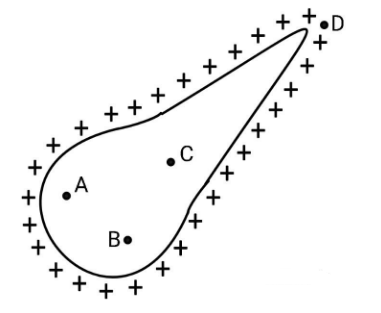
Answer
427.5k+ views
Hint: We are given an isolated conductor whose surface is charged. The conductor is non-uniform and thus the charge densities will be different at different areas of the surface. Isolated conductor means that in the whole space, you just consider the conductor alone and nothing else. Check the electric field inside a conductor, what will be the electric field inside a conductor and then use the relation between electric field and electric potential to find the potential at different points inside the conductor.
Complete answer:
First, let us find the electric field inside the conductor.Consider a conductor. As it is a conductor, it will have charges inside it, positive as well as negative. Apply an external field ${\overrightarrow E _{ext}}$. This external electric field will apply force on the charges, positive charges will go in the direction of force and negative charges will go in the opposite direction. These opposite charges will form a new internal electric field such that it cancels the effect of the external electric field. The charges appear on the surface of the conductor and the electric field inside the conductor will be zero.
The relation between the electric field and the electric potential is given as $E = - \dfrac{{dV}}{{dx}}$ where $V$ is electric potential. Consider this equation for the above discussed case. The electric field inside the conductor is zero and hence, we have $E = - \dfrac{{dV}}{{dx}} = 0$ i.e, $V$ is constant. So, the electric potential inside the conductor does not change and is the same everywhere.
Consider the potential of the surface of the conductor to be ${V_0}$, then the potential at every point inside the conductor will be ${V_0}$ because as you go from surface to any point inside the conductor, the potential will not change and has to be the same as that at the surface. As the point D is on the surface, the potential of point D be ${V_0}$, we will have, ${V_0} = {V_D}$ and as the potential does not change, we will have, ${V_0} = {V_A} = {V_B} = {V_C}$.From the above two derived equations, we have ${V_A} = {V_B} = {V_C} = {V_D}$.
Hence, option D is the correct answer.
Note: Always remember that the electric field inside a conductor is always zero which forces the potential at everywhere point inside the conductor to be the same. Also keep in mind the relation between the electric field and the potential. Also remember the properties we used to make conclusions about the electric field inside a conductor (about the charge distribution).
Complete answer:
First, let us find the electric field inside the conductor.Consider a conductor. As it is a conductor, it will have charges inside it, positive as well as negative. Apply an external field ${\overrightarrow E _{ext}}$. This external electric field will apply force on the charges, positive charges will go in the direction of force and negative charges will go in the opposite direction. These opposite charges will form a new internal electric field such that it cancels the effect of the external electric field. The charges appear on the surface of the conductor and the electric field inside the conductor will be zero.
The relation between the electric field and the electric potential is given as $E = - \dfrac{{dV}}{{dx}}$ where $V$ is electric potential. Consider this equation for the above discussed case. The electric field inside the conductor is zero and hence, we have $E = - \dfrac{{dV}}{{dx}} = 0$ i.e, $V$ is constant. So, the electric potential inside the conductor does not change and is the same everywhere.
Consider the potential of the surface of the conductor to be ${V_0}$, then the potential at every point inside the conductor will be ${V_0}$ because as you go from surface to any point inside the conductor, the potential will not change and has to be the same as that at the surface. As the point D is on the surface, the potential of point D be ${V_0}$, we will have, ${V_0} = {V_D}$ and as the potential does not change, we will have, ${V_0} = {V_A} = {V_B} = {V_C}$.From the above two derived equations, we have ${V_A} = {V_B} = {V_C} = {V_D}$.
Hence, option D is the correct answer.
Note: Always remember that the electric field inside a conductor is always zero which forces the potential at everywhere point inside the conductor to be the same. Also keep in mind the relation between the electric field and the potential. Also remember the properties we used to make conclusions about the electric field inside a conductor (about the charge distribution).
Recently Updated Pages
Who among the following was the religious guru of class 7 social science CBSE

what is the correct chronological order of the following class 10 social science CBSE

Which of the following was not the actual cause for class 10 social science CBSE

Which of the following statements is not correct A class 10 social science CBSE

Which of the following leaders was not present in the class 10 social science CBSE

Garampani Sanctuary is located at A Diphu Assam B Gangtok class 10 social science CBSE

Trending doubts
Which are the Top 10 Largest Countries of the World?

In what year Guru Nanak Dev ji was born A15 April 1469 class 11 social science CBSE

A rainbow has circular shape because A The earth is class 11 physics CBSE

How do you graph the function fx 4x class 9 maths CBSE

Fill the blanks with the suitable prepositions 1 The class 9 english CBSE

In Indian rupees 1 trillion is equal to how many c class 8 maths CBSE

The Equation xxx + 2 is Satisfied when x is Equal to Class 10 Maths

Why is there a time difference of about 5 hours between class 10 social science CBSE

Difference between Prokaryotic cell and Eukaryotic class 11 biology CBSE





